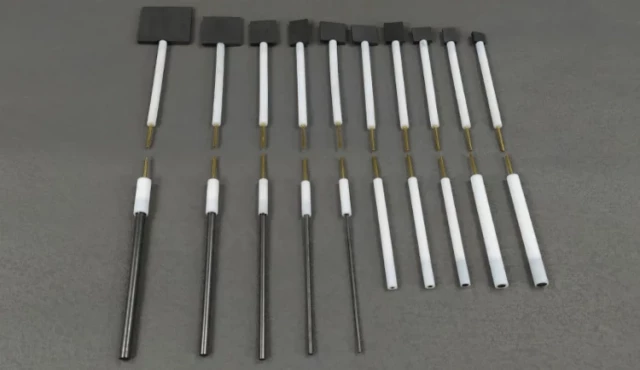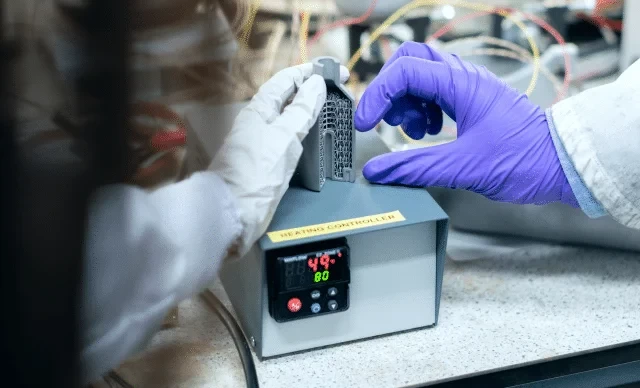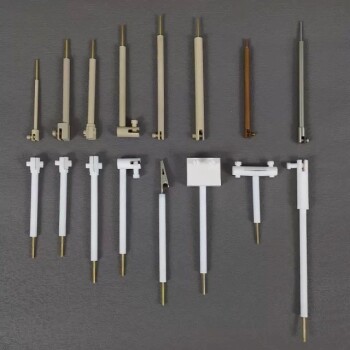Introduction to Reference Electrodes
Reference electrodes are essential tools in electrochemistry for measuring electrode potentials. They provide a stable and known potential that other electrodes can be compared to, allowing for accurate measurements of electrochemical reactions. A reference electrode consists of a half-cell that is constructed with a specific electrode potential against which an unknown potential can be measured. It is generally connected to a working electrode and an auxiliary electrode to form an electrochemical cell. The reference electrode must have a stable potential that is not affected by the solution's composition, temperature, and other factors. In the next sections, we will explore the purpose, construction, and types of reference electrodes in more detail.
Table of Contents
Purpose of Reference Electrodes
Reference electrodes are an essential tool in electrochemistry, serving as a stable reference point to measure the potential difference between two electrodes. They are designed to have a stable and known potential, which can be used as a point of comparison for other electrodes in the system. The purpose of a reference electrode is to ensure accurate and reproducible measurements in electrochemical experiments.

Electrode Potential
For electrochemical measurements, it is essential to have a reference point with a constant potential. The overall chemical reaction taking place in a cell is made up of two independent half-reactions, which describe chemical changes at the two electrodes. To focus on the reaction at the working electrode, the reference electrode is standardized with constant (buffered or saturated) concentrations of each participant of the redox reaction.
Complete the Electrical Circuit
The purpose of the reference electrode is to complete the electrical circuit necessary for an electrochemical measurement by providing the second electrode of a complete electrode cell whose total potential is measured. The reference electrode achieves this by providing contact with the sample through its liquid junction. For a reference electrode to be useful, it must provide both a stable and reproducible potential to which the indicating electrode potential can be compared.
Accuracy and Reproducibility
Reference electrodes play a critical role in ensuring accurate and reproducible data. The potential of the reference electrode should remain constant throughout the experiment to maintain the accuracy of the measurements. Any variation in the potential of the reference electrode can affect the potential of the working electrode and, therefore, the accuracy of the experiment.
Types of Reference Electrodes
There are various types of reference electrodes, including the silver/silver chloride electrode, the calomel electrode, the saturated calomel electrode, and the Ag/Ag2S electrode. The choice of reference electrode depends on the application. The silver/silver chloride electrode is the most commonly used reference electrode, and it has a stable potential of +0.197 V vs. the standard hydrogen electrode. Other reference electrodes include the calomel electrode, the saturated calomel electrode, and the Ag/Ag2S electrode.
Other Applications
In addition to their use in electrochemical experiments, reference electrodes are also used in other applications, such as pH measurement and corrosion monitoring. The potential of the reference electrode can be used to determine the pH of a solution, and it can also be used to monitor the corrosion of metals.
In summary, reference electrodes play a crucial role in electrochemical experiments, providing a stable and reproducible potential for accurate measurements. The choice of reference electrode depends on the application's requirements, and it is essential to maintain the reference electrode's potential throughout the experiment to ensure accuracy and reproducibility.
Construction of Reference Electrodes
Reference electrodes are used to establish a stable reference potential against which the potential of the working electrode can be measured. The construction of a reference electrode involves three main components: a reference electrode potential, an electrolyte solution, and an electrode body.
Reference Electrode Potential
The reference electrode potential is established by using a half-cell reaction, which generates a stable potential. The half-cell reaction is typically made up of a metal/metal ion pair, such as the Ag/Ag+ or Cu/Cu2+ pair. This generates a stable potential that can be used as a reference for electrochemical measurements.
Electrolyte Solution
The electrolyte solution is typically a salt solution that connects the reference electrode to the working electrode. The most commonly used electrolyte solution is saturated KCl, which is used in the construction of the Saturated Calomel Electrode (SCE). Other electrolyte solutions include NaCl, LiCl, and HCl.
Electrode Body
The electrode body is made up of a material that is chemically inert and electrically conductive, such as silver, platinum, or gold. The electrode body is typically coated with a layer of metal or metal oxide that is in equilibrium with the electrolyte solution. This layer serves as the active electrode surface and is responsible for maintaining a stable reference potential.
The most commonly used reference electrode is the Saturated Calomel Electrode (SCE). The SCE consists of a Hg/Hg2Cl2 electrode potential, a KCl electrolyte solution, and a glass electrode body. The Hg/Hg2Cl2 electrode potential is established by the following half-cell reaction:
Hg2Cl2(s) + 2e- ↔ 2Hg(l) + 2Cl-(aq)
The KCl electrolyte solution connects the SCE to the working electrode, while the glass body provides mechanical support for the electrode.
Another commonly used reference electrode is the Ag/AgCl electrode. The Ag/AgCl electrode potential is established by the following half-cell reaction:
AgCl(s) + e- ↔ Ag(s) + Cl-(aq)
The Ag/AgCl electrode can be constructed using a silver wire as the electrode body and a layer of AgCl as the active electrode surface.
Overall, understanding the construction of reference electrodes is essential for electrochemical measurements, as it enables the selection of the appropriate reference electrode for a given application. The selection of the reference electrode can significantly impact the accuracy and reliability of electrochemical measurements, and thus, it is crucial to choose the appropriate reference electrode for a given application.
Liquid Junctions in Reference Electrodes
Reference electrodes are essential for accurate measurements and reliable results in electrochemical experiments. One critical aspect of reference electrodes is liquid junctions, which are the points where the electrolyte solution of the reference electrode meets the solution being measured. When a reference electrode is placed into the sample, a potential develops at the junction where the reference filling solution and sample meet - the liquid junction. This potential develops because the reference filling solution is of different composition than the sample. The liquid junction is designed to allow interdiffusion of ions between the reference filling solution and the sample.
Importance of Liquid Junctions
To ensure accurate measurements, it is essential to use reference electrodes with well-designed liquid junctions that minimize the potential difference. The junction potential, which can impact the accuracy of measurements, arises at these points due to differences in ionic concentrations. Therefore, careful selection of the liquid junction material and the reference filling solution used is necessary to control both the magnitude and stability of the reference junction potential.
Reference Filling Solutions
Ideal reference filling solutions for any particular application should meet specific requirements. The filling solution's electrolyte should neither react with nor contaminate the sample. The filling solution should provide the dominant ions (in concentration) present at the liquid junction interface. The diffusion rates of both the cations and anions of the filling solution's electrolyte should be as close to equal as possible. One example of the first requirement is the typical reference filling solution of KCl reacting with a sample containing Silver to form silver chloride.
Ionic Equivalent Conductance
The ability of an ion to carry an electrical charge can be compared based on its ionic equivalent conductance (λ0, mho-cm/equivalent/liter). The ionic equivalent conductance for different ions in various solutions can vary significantly. For instance, Potassium has a limiting equivalent conductance of 73.5, while Chloride has a limiting equivalent conductance of 76.4. The higher limiting equivalent conductance values for H+ and OH- make achieving equitransference in strong acids and strong bases difficult.
Various Types of Liquid Junctions
There are two basic classes of liquid junctions - "flowing" and "diffusion" junctions. The flowing junctions allow the electrolyte in its entirety (liquid/gel and all) to make contact with the sample through the junction. The diffusion junction, on the other hand, allows only the ions of the electrolyte to pass through the junction and into the test sample.
Annular ceramic, ceramic wick, P.T.F.E. (Teflon), glass sleeve, and open aperture are the various types of liquid junctions that are available for reference electrodes. The choice of liquid junction type is mostly application-dependent. For example, the annular ceramic junction is suitable for most general laboratory-type applications, while the open aperture junction is typically used in applications having high solids content and in suspensions/emulsions.
In conclusion, understanding the importance of liquid junctions in reference electrodes is crucial for accurate measurements and reliable results in electrochemical experiments. Careful selection of the liquid junction material and the reference filling solution used is necessary to control the magnitude and stability of the reference junction potential. The choice of liquid junction type is mostly application-dependent.
Types of Aqueous Reference Electrodes
When conducting electrochemical experiments, it is important to have a reference electrode to measure the potential of the working electrode. There are various types of aqueous reference electrodes available, each with its own advantages and disadvantages.

Silver/Silver Chloride Electrode
The most common type of aqueous reference electrode is the silver/silver chloride electrode. It is easy to use and has a stable potential, making it a popular choice for many applications.
Calomel Electrode
Another widely used aqueous reference electrode is the calomel electrode. It is low cost and reliable, but it contains toxic mercury, making it less environmentally friendly.
Saturated Calomel Electrode
The saturated calomel electrode is a more accurate reference electrode, but it is also more expensive and requires careful handling.
Other Types of Aqueous Reference Electrodes
Other types of aqueous reference electrodes include the copper/copper sulfate electrode, the mercury/mercurous sulfate electrode, and the hydrogen electrode. Each reference electrode has its own specific applications, and it is important to choose the appropriate reference electrode based on the requirements of the experiment.
Understanding the different types of aqueous reference electrodes is crucial for beginners in electrochemistry, as it can impact the accuracy and reliability of the experimental results. It is important to note that commercially available aqueous Ag/AgCl reference electrodes should be stored in the dark and submerged in solutions that are identical to the solution inside the reference electrode, usually saturated KCl.
It is also essential to prevent the vycor frit from drying out, which causes the electrolyte salt to crystallize in the pores and render it unusable. The integrity of a vycor frit can be tested by attempting to squeeze liquid through it using a pipette bulb; if fluid filters though easily, the vycor frit should be replaced.
For non-aqueous electrochemical experiments, a reference electrode can be made easily from commercially available (or recycled) glass reference electrode compartments, vycor frits, and silver wire. As in the case of aqueous reference electrodes, the silver wire should be submerged in a solution of the same solvent that has the same concentration of electrolyte salt (preferably using the same salt) as the solution containing the analyte.
In conclusion, understanding the different types of aqueous reference electrodes is crucial for beginners in electrochemistry. It is important to choose the appropriate reference electrode based on the requirements of the experiment as it can impact the accuracy and reliability of the experimental results.
Counter Electrode (CE) in Electrochemistry
In an electrochemical cell, reference electrodes are used to measure the potential difference between two half-cells. One of the essential components of a reference electrode is the counter electrode (CE), also known as the auxiliary electrode.
Role of Counter Electrode
The CE is crucial in completing the electrical circuit in an electrochemical cell. Its role is to provide a stable and consistent electrical potential, which helps to maintain the current flow in the circuit. It is usually made of an inert material, such as platinum, and is placed in proximity to the working electrode. The CE does not participate in the electrochemical reaction but provides a stable electrical potential that is used as a reference for measuring the potential difference.
Counter Electrode in Two-Electrode Setups
Two-electrode setups are used in cases where measurement of the whole cell voltage is significant, for example, in electrochemical-energy devices like batteries, fuel cells, and supercapacitors. The CE potential can be expected not to drift over the course of the experiment. This is generally in systems which exhibit very low currents or relatively short timescales and which also have a well-poised counter, e.g., a micro working electrode and a much larger silver counter electrode.
Counter Electrode in Three-Electrode Experiments
In three electrode mode, the reference lead is separated from the counter and connected to a third electrode. This electrode is positioned so that it is measuring a point very close to the working electrode. Three-electrode setups have a distinct experimental advantage over two-electrode setups: they measure only one half of the cell. That is, the potential changes of the working electrode are measured independent of changes that may occur at the counter electrode. This isolation allows for a specific reaction to be studied with confidence and accuracy. For this reason, 3-electrode mode is the most common setup used in electrochemical experimentation.
Counter Electrode in Four-Electrode Experiments
In four-electrode mode, the Working Sense lead is decoupled from the working electrode, as was (and in addition to) the Reference lead. Four-electrode setups measure potential along the B-D line in Figure 3, where there may be some “obstruction” at C. This setup is relatively uncommon in electrochemistry, though it does have its place. In 4-electrode mode, the potentials for any electrochemical reactions that are occurring at the working (and counter) electrode(s) are not being measured. What is being measured is the effect of an applied current on the solution itself or some barrier in that solution.
Counter Electrode Separation and Potential Change
If there is some trepidation that the electrolytic reaction product at the counter electrode may affect the desired electrolysis reaction, it is desirable to place the counter electrode in a compartment separated from the working electrode. Particularly in bulk electrolysis, in order to avoid the working electrode product reverse electrolysis at the counter electrode, it must be installed in a compartment separated by an ion exchange membrane or a ceramic filter.
The potential of the working electrode is clearly regulated respecting to the reference electrode potential by the potentiostat, however, the potential of the counter electrode is unknown. The potential of the counter electrode vibrates following the current value of the working electrode. In the counter electrode, if the supporting electrode reaction is insufficient, the overvoltage must also increase. Considering this, the surface area of the counter electrode should be increased as much as possible, and the current density should be decreased.
Conclusion
In conclusion, the counter electrode is an essential component of an electrochemical measurement system. Its role is to provide a stable and consistent electrical potential, which helps to maintain the current flow in the circuit. The counter electrode does not participate in the electrochemical reaction but provides a stable electrical potential that is used as a reference for measuring the potential difference. Understanding the significance of the counter electrode in electrochemistry is vital for beginners to appreciate the importance of reference electrodes in electrochemical measurements.
Related Products
- Reference Electrode Calomel Silver Chloride Mercury Sulfate for Laboratory Use
- Copper Sulfate Reference Electrode for Laboratory Use
- Rotating Platinum Disk Electrode for Electrochemical Applications
- Electrode Polishing Material for Electrochemical Experiments
- Gold Electrochemical Sheet Electrode Gold Electrode
Related Articles
- Electrochemical Electrodes in Chemical Analysis
- Reference Electrodes: Calomel, Silver Chloride, and Mercury Sulfate - A Comprehensive Guide
- Electrolytes and Electrochemical Electrodes
- How to Make Your Own Ag/AgCl Reference Electrode for Electrochemical Experiments
- AgAgCl Reference Electrode Working Principle and Applications














